Robert Knox's Blog, page 48
October 20, 2015
The Garden of Verse: Verse-Virtual's Octoberists
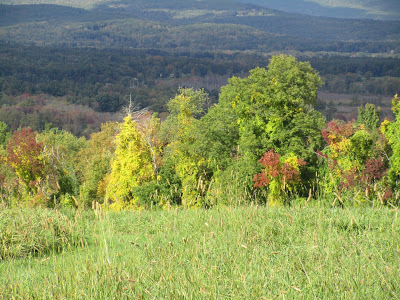 Verse-Virtual's October poets packed whole worlds into a few lines. Below I'm sampling some of the many instances of strong writing -- imagery, diction, the telling detail -- that called to me in the October issue of Verse-Virtual.com. Van Harmann's positively haunting "Nevada Test Site" (a reference to atom bomb tests conducted there in 1957) includes this intensely evoked moment in a personal, family, and national drama:
Verse-Virtual's October poets packed whole worlds into a few lines. Below I'm sampling some of the many instances of strong writing -- imagery, diction, the telling detail -- that called to me in the October issue of Verse-Virtual.com. Van Harmann's positively haunting "Nevada Test Site" (a reference to atom bomb tests conducted there in 1957) includes this intensely evoked moment in a personal, family, and national drama:I am twelve, have just begun to sprout
a map of sinews, muscles, veins,
have not yet found a voice
within my strange unstable throat,
too young to know the cause
of his howling wind
that can erupt without warning
from a man who can coax
a bluebird to take a peanut
from his open palm.[http://www.verse-virtual.com/van-hart...]
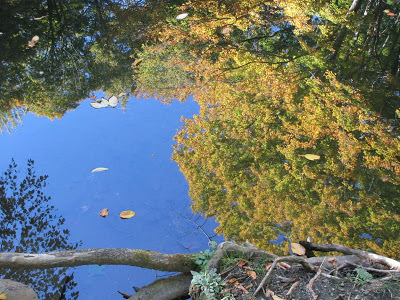 Steve Klepetar's "Li Bo Drinks From the Well of Forgetfulness" draws on the experiences of a fictional character who appears to be a combination of poet, avatar, and explorer of human consciousness. The poem shines with vivid imagery, including this depiction of life's precious, concrete, sensual thereness:
Steve Klepetar's "Li Bo Drinks From the Well of Forgetfulness" draws on the experiences of a fictional character who appears to be a combination of poet, avatar, and explorer of human consciousness. The poem shines with vivid imagery, including this depiction of life's precious, concrete, sensual thereness:He is a watchman on the road to midnight
who recalls how coins feel as they fall
into his hand, silver jingling against copper
and gold. He remembers a brown house
with windows blinking like a hundred eyes,
a yellow dog circling and dragging its chain,
a tall girl painting in a meadow beyond the pines.[http://www.verse-virtual.com/steve-kl...]
Frederick Pollack's tight-lipped, hard-eyed sketch of postwar life in these United States (in "Carl"), a history book in a few unadorned stanzas, begins with these short lines that sum up an era:
The war, marriage
(on leave) to Evelyn.
Back, saying little,
to wholesale,
driven, unloaded,
inventoried, loaded …
A narrow house, a yard
with zucchini.
Two kids. The two-bus
commute till ’53 and
a first Chevy. Half of
everything saved. [http://www.verse-virtual.com/frederic...]
Robert Wexelblatt makes provocative use of rhyme and meter in two poems in the October V-V. From its lovely first stanza -- with its great leaf/word comparison: "each falling leaf a scarlet word that carves/ the air then fetches up against the fence" -- "In October" measures its way through a stirring month to its imagist conclusion in which the rhyming of 'voluminous' and 'numinous' yields the apt picture of fallen leaves turning leaves turning numinous.
In "The Emperor's Nose," which the poet calls a "patter poem," I particularly enjoyed seeing "Mikado" pop up and get paired with "avacado." A connection that I can honestly say has never once crossed my mind. Great fun and ingenuity throughout this poem.
Joyce Brown's powerful poem, "Trip Home" from its opening invocation of the Book of Common Prayer -- deliver us "from dying suddenly and unprepared" -- through various premonitions of a sudden and unwelcome end to this transitory existence (perhaps on the city transit), to its concluding sidelong glance at a certain river, or current of thought, we all glimpse now and again: At home, the dogs paddle through the grass
to greet me. In the corner of my eye,
the River Styx slides by.
A few more memorable images, evocations and depictions from Verse-Virtual's Octoberists. In David Chorlton's "Entering Desert" we are lead to a place...
where you’re spinning around your own finger
that points at the sunas if offering directions.
Tony Gloeggler's gritty, concrete summation (in "Reading and Writing") of the failure of a literary evening to achieve liftoff:
Nothing
she read stepped on
the subway with you,
leaned over, whispered
into your ear anything
that made a difference.
Barbara Crooker's "Sceilig Mhichil: A Glosa," a poem about the hardy souls who clung to an island of rock in the Irish Seas during the Norseman raids in the Middle Ages:
... the steps rise
between fangs of rock, a space
to chasten or elevate souls. Feel
how it was to live in a clochán,
nothing but obdurate rock above and below.
In Europe, books burned, but here were concealed.
You can open these poems and scores of others currently up on Verse-Virtual.com. Click on the current issue and a list of poets' names will appear, numerous as the nameplates in a New York City high-rise. Then click on a name, and step into a poem.
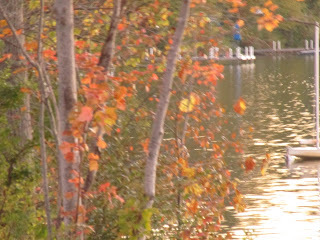
Published on October 20, 2015 19:53
October 18, 2015
The Garden of Song: 'Autumn in New York'
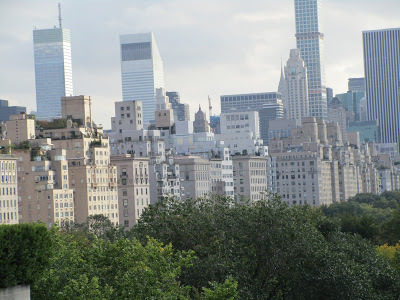
Billie Holiday sang "Autumn in New York," a semi-sweet lyric with a great first line: "Autumn in New York, why does it seem so inviting?"
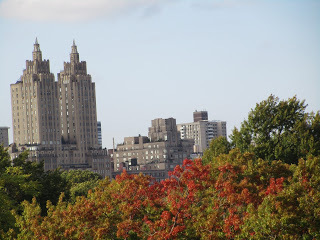 Some other memorable lines from the song:
Some other memorable lines from the song: "It's autumn in New York that brings the promise of new love
Autumn in New York is often mingled with pain
Dreamers with empty hands, may sigh for exotic lands..."
We paid an autumn visit to New York last week.
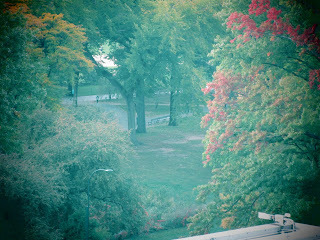 Here are some impressions of a few action-packed days -- also traffic-packed, parking-challenged, debate-filled, city-stimulating days -- which I may characterize as the good, the bad, and the spectacular. I'll start with the worst: Do not drive to New York City at the end of the Columbus Day weekend. Attempting to do so yields those moments (and hours) when the ego shrieks inside, "Never Do this again!" This is s probably a big "not to do" at the end of any three-day weekend. (Maybe not at the beginning either.) Anne and I have in earlier years discovered that both Thanksgiving and Christmas mornings are great times to drive from Boston to New York City, before anybody is on the road to Grandma's house for a holiday feast. (Except us.) Late afternoon on Columbus Monday, however, must be the pits. It makes you want to change the name to Indigenous Americans Day and prohibit all travel by any vehicle not available before 1492. Since we had been on vacation all week because of the visit by our daughter and her boyfriend, the end of the three-day weekend somehow escaped me. "Stupid!" I said, pounding my head on the steering wheel as we slogged through the third (or was it fourth?) hour of the Connecticut Turnpike. OK, we make it, but things get, in their peculiarly Big Apple way, worse later that night -- it gets late soon, unhappily, after all those hours on the road -- when we try to park at our Airnb "accommodation" (hostel? room? ad hoc B'n'B?). To take the crowding load off the grandparents' townhouse we had decided on this debut initiative. On the scale of good, bad or horrendous, I would describe the experience as "OK." If you plan to arrive at your destination with no other need than to put your head on the pillow, Airnb is probably more than all right. If the arrangement offers convenience at a reasonable cost, what more to do you want out of a sleeping place? Our room was fine, it offered superior window view over the northern tip of the Bronx, and our hosts couldn't have been kinder.
Here are some impressions of a few action-packed days -- also traffic-packed, parking-challenged, debate-filled, city-stimulating days -- which I may characterize as the good, the bad, and the spectacular. I'll start with the worst: Do not drive to New York City at the end of the Columbus Day weekend. Attempting to do so yields those moments (and hours) when the ego shrieks inside, "Never Do this again!" This is s probably a big "not to do" at the end of any three-day weekend. (Maybe not at the beginning either.) Anne and I have in earlier years discovered that both Thanksgiving and Christmas mornings are great times to drive from Boston to New York City, before anybody is on the road to Grandma's house for a holiday feast. (Except us.) Late afternoon on Columbus Monday, however, must be the pits. It makes you want to change the name to Indigenous Americans Day and prohibit all travel by any vehicle not available before 1492. Since we had been on vacation all week because of the visit by our daughter and her boyfriend, the end of the three-day weekend somehow escaped me. "Stupid!" I said, pounding my head on the steering wheel as we slogged through the third (or was it fourth?) hour of the Connecticut Turnpike. OK, we make it, but things get, in their peculiarly Big Apple way, worse later that night -- it gets late soon, unhappily, after all those hours on the road -- when we try to park at our Airnb "accommodation" (hostel? room? ad hoc B'n'B?). To take the crowding load off the grandparents' townhouse we had decided on this debut initiative. On the scale of good, bad or horrendous, I would describe the experience as "OK." If you plan to arrive at your destination with no other need than to put your head on the pillow, Airnb is probably more than all right. If the arrangement offers convenience at a reasonable cost, what more to do you want out of a sleeping place? Our room was fine, it offered superior window view over the northern tip of the Bronx, and our hosts couldn't have been kinder.
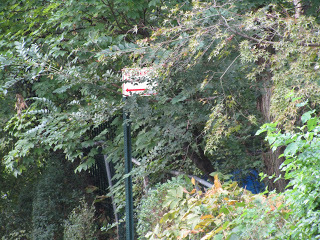 But they could not however provide us a parking space. If you need to park a private vehicle on the streets of New York City, what you are likely to experience is endless driving, or crawling along residential side streets, eyeballing how close you are to that hydrant, or this driveway, and deciding almost always you're too close for parking. So we give up and head for the parking garage only to discover it closes at 11 p.m. and we are now gated out. In the end, following our host's reluctant suggestion, we park on a leafy corner next to a partially obscured "no parking" sign (see photo above). In the morning (early) Anne is greeted by a summons from the killer New York parking gestapo. In that same "safe," "desirable" residential neighborhood, now on foot, we encounter the barking-cop voice at the traffic signal's walk light. When the light is red a recorded voice shouts an angry-rude New Yorker "Wait!" "Wait!" every ten seconds or so, reducing an otherwise peaceful public space to a crowded hallway of unruly first graders. Is this what keeping the peace has come to in "fun city"? City buses also have recordings where a male cop voice shouts "no"-this and "no"-that a half dozen times at every stop. On the other hand, the buses run regularly enough to be useful (more than you say for most other cities). Well, of course, lots of good to report as well. Autumn in New York is beautiful, in part because any threat of a sweltering, humid, urban-jungle weather day is now likely past. You can walk around comfortably and enjoy the urban texture of mid-town, townhouses with expertly wedged landscaping and floral color, leaves turning, the dense and varied street scape, the dramatic skyline, and the nonstop diversion of a lively parade of humanity down every avenue. We walked along Central Park to the Metropolitan Museum of Art, and eventually made our way up to the newly opened Roof Garden... where the views are, simply, exhilarating (top three photos). This was the spectacular part of the day. As the song says, unexpected pleasures of "Autumn in New York" such as these make you feel good to be alive. We'll leave the last lines to Billie:
But they could not however provide us a parking space. If you need to park a private vehicle on the streets of New York City, what you are likely to experience is endless driving, or crawling along residential side streets, eyeballing how close you are to that hydrant, or this driveway, and deciding almost always you're too close for parking. So we give up and head for the parking garage only to discover it closes at 11 p.m. and we are now gated out. In the end, following our host's reluctant suggestion, we park on a leafy corner next to a partially obscured "no parking" sign (see photo above). In the morning (early) Anne is greeted by a summons from the killer New York parking gestapo. In that same "safe," "desirable" residential neighborhood, now on foot, we encounter the barking-cop voice at the traffic signal's walk light. When the light is red a recorded voice shouts an angry-rude New Yorker "Wait!" "Wait!" every ten seconds or so, reducing an otherwise peaceful public space to a crowded hallway of unruly first graders. Is this what keeping the peace has come to in "fun city"? City buses also have recordings where a male cop voice shouts "no"-this and "no"-that a half dozen times at every stop. On the other hand, the buses run regularly enough to be useful (more than you say for most other cities). Well, of course, lots of good to report as well. Autumn in New York is beautiful, in part because any threat of a sweltering, humid, urban-jungle weather day is now likely past. You can walk around comfortably and enjoy the urban texture of mid-town, townhouses with expertly wedged landscaping and floral color, leaves turning, the dense and varied street scape, the dramatic skyline, and the nonstop diversion of a lively parade of humanity down every avenue. We walked along Central Park to the Metropolitan Museum of Art, and eventually made our way up to the newly opened Roof Garden... where the views are, simply, exhilarating (top three photos). This was the spectacular part of the day. As the song says, unexpected pleasures of "Autumn in New York" such as these make you feel good to be alive. We'll leave the last lines to Billie:"Its autumn in New York, its good to live it again.Autumn in New York, the gleaming rooftops at sundown
Autumn in New York, it lifts you up when you're run down
...Autumn in New York, you'll need no castle in Spain
Lovers that bless the dark on benches in Central Park
Greet autumn in New York, its good to live it again."
Published on October 18, 2015 15:17
October 17, 2015
The Garden of Poetry: Election Fever, Too Hot, Too Soon

Does it have to be about the money? All about the money. It's October, one whole year plus part of a month before the next Presidential election, but according to all the major media -- and the candidates' own campaign postings -- our future is being decided right now.
 That's not because of the presidential primaries. They don't start until 2016. But for months already -- months -- we've been told that what the candidates are saying, or not saying, doesn't really matter all that much. Their poll numbers matter somewhat, but what matters more than anything else, almost to the exclusion of anything else, is how much money they are raising for their campaigns. Consider a typical front-page story in yesterday's New York Times, headlined "Which Presidential Candidates Are Winning the Money Race." The story analyzes which campaigns have the strongest chance to persevere based on how money they've raised so far, and in the last three months. The crucial facts: "Hillary Rodham Clinton raised $29.9 million for her campaign in the third quarter, just ahead of Bernie Sanders, who raised $26.2 million." (Here's the link: http://www.nytimes.com/interactive/20...)
That's not because of the presidential primaries. They don't start until 2016. But for months already -- months -- we've been told that what the candidates are saying, or not saying, doesn't really matter all that much. Their poll numbers matter somewhat, but what matters more than anything else, almost to the exclusion of anything else, is how much money they are raising for their campaigns. Consider a typical front-page story in yesterday's New York Times, headlined "Which Presidential Candidates Are Winning the Money Race." The story analyzes which campaigns have the strongest chance to persevere based on how money they've raised so far, and in the last three months. The crucial facts: "Hillary Rodham Clinton raised $29.9 million for her campaign in the third quarter, just ahead of Bernie Sanders, who raised $26.2 million." (Here's the link: http://www.nytimes.com/interactive/20...)American democracy in the 21st century? It's about the money. I wrote a poem responding to the constant appeals for money many of us are receiving these days from candidates. And not only the major presidential candidates. From candidates for key Senate and Congressional districts, especially in so-called "contested," "closely watch" races in "battleground" states and districts. Some of these heart-rending, breathless, life-or-death appeals come from candidates I've never heard of, from states I can't vote in. That is, I can't vote for these people. But I can -- thanks to the current American political system, the Supreme Court, and the billionaires and corporations who dominate American policy making -- give money to them. So which really matters? Voting? Or money. My poetic fantasy protest to this outrageous state of affairs is the poem, titled "From Out of the Inbox," in which I ask the apparently ridiculous question "isn't there some other way in which we can show our support for candidates who represent our views and aspirations for life in these United States?" It appears in the October issue of Verse-Virtual. Here's the link: http://www.verse-virtual.com/robert-c...
From Out of the Inbox
I delete the forty-two solicitations for campaign donations
from the little people
to combat the rivers of invisible money spewed
by the other side's billionaires
Our billionaires apparently are not so fluent
We are 'the little people'
I see us hurrying off to work
carrying our battered briefcases, umbrellas exploding in
the storms of autumn, freezing our tushes
on the frozen sidewalks in the winter of the century,
scampering beneath the heavy boots
and skyscraper legs of the corporate storm-troopers
Why can we fight money only with more of the same?
Why can't we donate paper flowers,
old Valentines with crayoned kisses, children's report cards with
the A's circled, clever bowls of kale salad
the smiles of knee-high nieces coaxed by frequent application
of sugary liquids,
pencil-worn scorecards with the names of diamond idols
seen now only in the studio wrap-up
lamenting that hanging slider in the top of the seventh?
Why does the permanent political class
expect to get paid when the only interest
served by marathon campaign carnivals
that crowd the air with Ferris wheels of denigration
and roller-coasters of paid duplicity
is their own?
I walk in a garden of video promises
digital invitations with sticky fingers
breath-taking ascents to rhetorical prospects where the air is thin
transitory surveys, singular snapshots of
a moving stream of media eventualities
in which we float, we little people,
on folded paper boats carrying our little piles
of GW's portrait, we pioneers of vox populi percuniae
praying for pennies from heaven
when the rainbow coalition is enuf
Published on October 17, 2015 21:29
October 12, 2015
In the Garden of Those Creature Who Truly Live There: Mantises
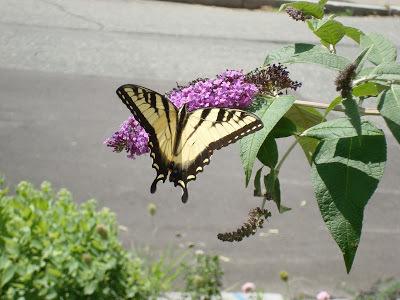
Is it a Praying Mantis? Or a Preying Mantis? As the snapshot ID by National Geographic laconically puts it, the mantis is a "carnivore." "By any name," the NG continues in its online article (http://animals.nationalgeographic.com...) "these fascinating insects are formidable predators."
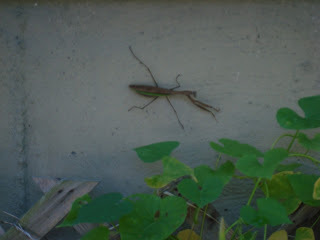 The article also tells us they should be called "praying mantids" even though the genus they belong to is "mantis." In addition to the elongated thorax, formidable front legs (bent to an ankle suggestive of "praying"), and their two large compound eyes -- which, I can testify, give a convincing impression of looking straight at you -- their heads can swivel a full 180 degrees, like some robotic humanoid. Indeed, I suspect when the insect kingdom replaces hominids as the dominant life form in the unknowable future of planet earth, some of them will look like your boss and behave like aircraft carrier flight controller, scanning the friendly skies. The National Geographic notes how well camouflaged these formidable hunters are as they "lie in ambush or patiently stalk their quarry." Their reflexes are so fast they can be hard to see with naked eye, but again, drawing on personal observation, I have seen one strike but miss catching a honey bee. On the other hand, maybe he didn't really want to catch it when he saw what he was hunting. The praying mantis's lower legs have spikes for holding on to what they do catch, the article tells us, while their jaws go after the tastier parts. "Moths, crickets, grasshoppers, flies, and other insects are usually the unfortunate recipients of unwanted mantid attention." In our case, the unfortunate victims are butterflies. The large mantises that stalk our garden disguise themselves as a green and brown leaf hanging from the upper branch of a butterfly bush (bodelia) in the front garden, directly below a purple blossom (see top photo). It somehow knows that this is the place the butterflies like to hang out. We have seen Monarch butterflies rest here for hours. So, last month when I happened to glance in that direction and noticed the wings of a black butterfly flapping wildly from side to side I guessed what had happened and arrived on the scene like the cavalry, or some oversized air-rescue unit. Those formidable "preying" front legs had latched on to a wing while the butterfly struggled to escape. I noticed however that the butterfly -- it resembled a swallowtail -- still kept its head. (Literally). Unable to think of anything better, I swatted at the mantis, and both predator and pray fell from the branch into the thick ground cover. Camouflage hid the mantis from sight, but the black winged butterfly was lying in clear sight on a mound of thick Vinca leaves. So I picked up the butterfly, which made no attempt to fly and permitted me to carry it into the back of the garden far from the scene of the crime. I noticed a small tear in one of his wings. I decided to set the butterfly down on top of a thick stalk of another plant (a tall phlox) and hope that he could recover unmolested there. Or not. I am not really god of the garden insects. A few hours later when I went out to check on him the butterfly was gone. I took this absence as a favorable sign. I will conclude with some lines from the poem I wrote about another episode, when I caught two praying mantises in flagrante on that same bush. (Apparently; who really knows? I mean, they're insects.)
The article also tells us they should be called "praying mantids" even though the genus they belong to is "mantis." In addition to the elongated thorax, formidable front legs (bent to an ankle suggestive of "praying"), and their two large compound eyes -- which, I can testify, give a convincing impression of looking straight at you -- their heads can swivel a full 180 degrees, like some robotic humanoid. Indeed, I suspect when the insect kingdom replaces hominids as the dominant life form in the unknowable future of planet earth, some of them will look like your boss and behave like aircraft carrier flight controller, scanning the friendly skies. The National Geographic notes how well camouflaged these formidable hunters are as they "lie in ambush or patiently stalk their quarry." Their reflexes are so fast they can be hard to see with naked eye, but again, drawing on personal observation, I have seen one strike but miss catching a honey bee. On the other hand, maybe he didn't really want to catch it when he saw what he was hunting. The praying mantis's lower legs have spikes for holding on to what they do catch, the article tells us, while their jaws go after the tastier parts. "Moths, crickets, grasshoppers, flies, and other insects are usually the unfortunate recipients of unwanted mantid attention." In our case, the unfortunate victims are butterflies. The large mantises that stalk our garden disguise themselves as a green and brown leaf hanging from the upper branch of a butterfly bush (bodelia) in the front garden, directly below a purple blossom (see top photo). It somehow knows that this is the place the butterflies like to hang out. We have seen Monarch butterflies rest here for hours. So, last month when I happened to glance in that direction and noticed the wings of a black butterfly flapping wildly from side to side I guessed what had happened and arrived on the scene like the cavalry, or some oversized air-rescue unit. Those formidable "preying" front legs had latched on to a wing while the butterfly struggled to escape. I noticed however that the butterfly -- it resembled a swallowtail -- still kept its head. (Literally). Unable to think of anything better, I swatted at the mantis, and both predator and pray fell from the branch into the thick ground cover. Camouflage hid the mantis from sight, but the black winged butterfly was lying in clear sight on a mound of thick Vinca leaves. So I picked up the butterfly, which made no attempt to fly and permitted me to carry it into the back of the garden far from the scene of the crime. I noticed a small tear in one of his wings. I decided to set the butterfly down on top of a thick stalk of another plant (a tall phlox) and hope that he could recover unmolested there. Or not. I am not really god of the garden insects. A few hours later when I went out to check on him the butterfly was gone. I took this absence as a favorable sign. I will conclude with some lines from the poem I wrote about another episode, when I caught two praying mantises in flagrante on that same bush. (Apparently; who really knows? I mean, they're insects.) Too big for squeamish hands to touchtoo raw for greenleaf thoughts of preservation too distinguished in its regicidal enormity to ignorethough its body swims metamorphically into the green and brownof everyman's little spot of paradise
serpentine in her motions she knows what we don't care to hear let the gods, the elohim, keep track of the billion teeming soulsI step aside, indulge a somewhat less sullied patch of sun...
That is to say I let nature take its course. Looking for a scientific perspective on this behavior, I discovered a report on a widely observed practice by some insects and insect-like predators:That is, the females eat the males after copulation. In this report to which I have attached the subtitle "Good news for guys," one Kyle Hurley, an entomology student from the University of Central Arkansas, concluded that females do not in fact always, or even generally, eat their mates after coupling. The truth is more varied. In one case, I learned, the male actually ate the female; in another case the female ate the head of the male during the act, though this did not prevent the act's completion. The truer generalization, according to this study, is that female mantises “were selectively cannibalizing smaller males.” To which I can offer this advice to prospective male praying mantis progenitors: if you're a runt, you're lunch.
Published on October 12, 2015 11:47
October 11, 2015
Old Favorites and New Friends: October Lights in the Berkshires

Some new friends in the Berkshires. No, not the cows; we met them lying down on the job in a sunny pasture along the Housatonic. Though you can tell by the name tags on the ears that somebody loves them.
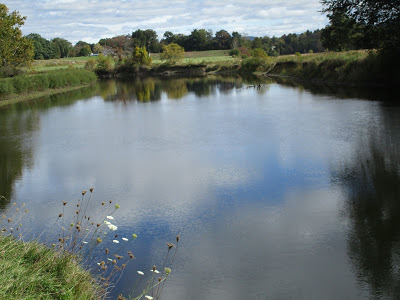
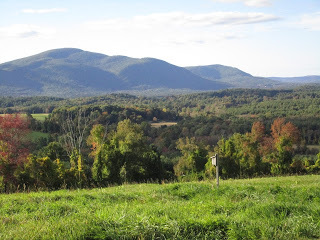
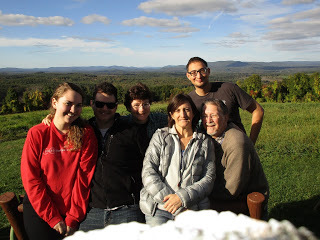 In our yearly visit to this area, the homeland of autumn in the annual calendar of our lives, we returned, like a migratory species, to the favorite places we visit each fall. The blue river in the second photo is the slow-winding Housatonic River that coils through the Trustees of Reservations property named Bartholomew's Cobble in Sheffield. At the end of a tour of the cobble (a low, thickly wooded hill featuring limestone walls with shallow caves), the path along the river, a good stare up at the second oldest cottonwood tree in the state of Massachusetts, a hike through a wooded path named after a singular tulip tree (not sure how high in the charts this tree rates), we confront a long, gentle ascent through a green pasture to the top of Hurlburt Hill. From there we have a view of the Berkshire hills to the north, east and west (third photo down). October is migratory season for hawks. We always see some floating on the warm updrafts from the sun-warmed hills.
In our yearly visit to this area, the homeland of autumn in the annual calendar of our lives, we returned, like a migratory species, to the favorite places we visit each fall. The blue river in the second photo is the slow-winding Housatonic River that coils through the Trustees of Reservations property named Bartholomew's Cobble in Sheffield. At the end of a tour of the cobble (a low, thickly wooded hill featuring limestone walls with shallow caves), the path along the river, a good stare up at the second oldest cottonwood tree in the state of Massachusetts, a hike through a wooded path named after a singular tulip tree (not sure how high in the charts this tree rates), we confront a long, gentle ascent through a green pasture to the top of Hurlburt Hill. From there we have a view of the Berkshire hills to the north, east and west (third photo down). October is migratory season for hawks. We always see some floating on the warm updrafts from the sun-warmed hills.
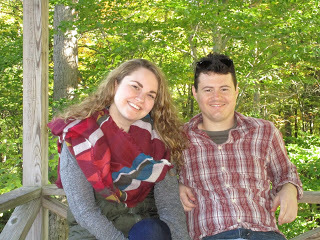 No photos here of the hawks. However, to make up for that oversight, some views of our old and new companions on this seasonal ritual are pictured here, gathered at the summit for a timer-setting group-selfie engineered by Sonya's companion Mourad. Even if several of us (Saul, Anne, partially me) have apparently gone over to the dark side. (Fourth photo)
No photos here of the hawks. However, to make up for that oversight, some views of our old and new companions on this seasonal ritual are pictured here, gathered at the summit for a timer-setting group-selfie engineered by Sonya's companion Mourad. Even if several of us (Saul, Anne, partially me) have apparently gone over to the dark side. (Fourth photo)
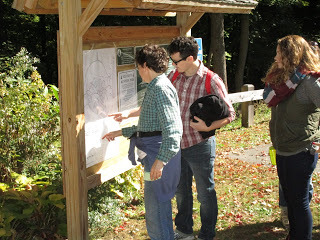 The next day took us to Kennedy Park. That's Anne, Saul and Emma (Saul's friend) inspecting the map of the superb wooded, trailed, and mapped Lenox park (sixth photo). From a prospect created by the power line cut, we look down on farmhouse far below (eighth photo). Our next stop, known as the 'overlook,' from which we can see Mount Greylock to the north, led to photo opportunities from the shed-like structure which overlooks the thickly treed hills that now hide most of the summits on the horizon. Photos were taken here: Sonya and Mourad (second from last photo). Emma and Saul (fifth photo down).
The next day took us to Kennedy Park. That's Anne, Saul and Emma (Saul's friend) inspecting the map of the superb wooded, trailed, and mapped Lenox park (sixth photo). From a prospect created by the power line cut, we look down on farmhouse far below (eighth photo). Our next stop, known as the 'overlook,' from which we can see Mount Greylock to the north, led to photo opportunities from the shed-like structure which overlooks the thickly treed hills that now hide most of the summits on the horizon. Photos were taken here: Sonya and Mourad (second from last photo). Emma and Saul (fifth photo down).
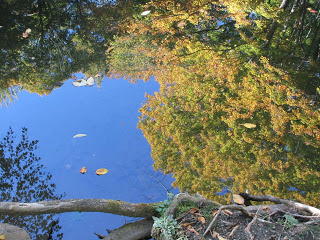 From there we hike to "the little pond" that stands as our icon for autumn peace. The pond has suffered incursions by beavers, who dragged some downed tree trunks and branches for a lodge that failed. And the water was low this year. But the surface still gives beautiful reflections of October trees (seventh photo).
From there we hike to "the little pond" that stands as our icon for autumn peace. The pond has suffered incursions by beavers, who dragged some downed tree trunks and branches for a lodge that failed. And the water was low this year. But the surface still gives beautiful reflections of October trees (seventh photo).
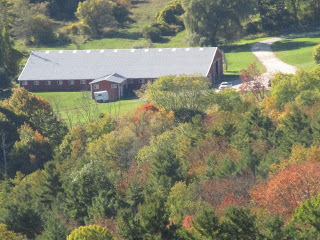 We did some more other, modest hikes as the weather grew milder and the autumn color grew stronger each day. Some wild turkeys took advantage of the fine weather to cross the cottage driveway. We counted about fifteen all told, but I could never get my camera to work fast enough to catch more than a couple in a frame (bottom photo).
We did some more other, modest hikes as the weather grew milder and the autumn color grew stronger each day. Some wild turkeys took advantage of the fine weather to cross the cottage driveway. We counted about fifteen all told, but I could never get my camera to work fast enough to catch more than a couple in a frame (bottom photo). 
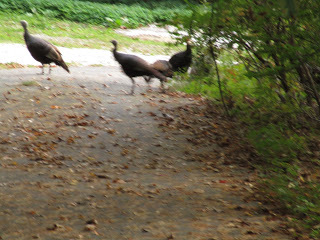 In the end, packed up for a fond farewell, we sat on the deck of the Stockbridge cottage and took another group selfie. (Not to be confused with the turkeys.)
In the end, packed up for a fond farewell, we sat on the deck of the Stockbridge cottage and took another group selfie. (Not to be confused with the turkeys.)
Published on October 11, 2015 10:57
October 2, 2015
The last day of September: the Elegaic Garden
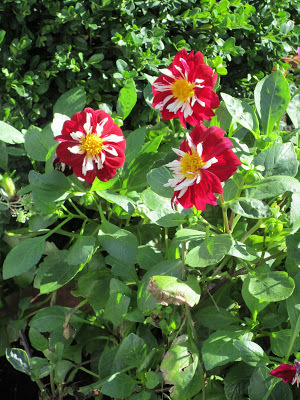
How often the weather changes in a distinctly seasonable fashion on the first day of the month! September, while it brings the major societal change of back to school, back to college, and (if you've had an August vacation) back to work, is seasonally speaking the last month of summer. Summer ran out, astronomically speaking, on Sept. 23 this year, a full week before the end of the month. But the weather didn't change then. September 2015, at least in Massachusetts, was an unusually warm September, the second warmest on record. Like the two previous months, we had lots of clear days -- good vibrations for the solar panels -- and lengthy periods without any substantial rain. (Going to California in my mind.) The sun is good for us and warmth ripens the tomatoes and makes any sun-loving plant want to grow and blossom and keep blossoming, but the lack of rain leaves you with a lot of parched-looking leaves, dried flowers, wilted profiles, stunted annuals, and unopened buds. Green lawns turn brown.
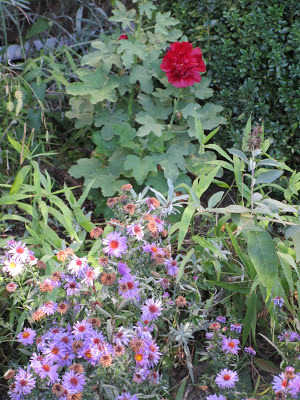 Obsessive gardeners (not mentioning any names here) finally accept that they have to water by hand every day, almost as if were living in the sunbelt. Things changed, just as if some meteorological divinity were counting the days, as we ran out of September. September 30th poured the first inches-count-of-rain day in half a year, sending a host of seasonal messages, including one clear point: put away the garden hose. ("You know," the next door neighbor kindly explained to me on the 29th, "we're going to be getting all this rain" when she discovered my day-long hose drip beneath the still-flagging rhododendron).
Obsessive gardeners (not mentioning any names here) finally accept that they have to water by hand every day, almost as if were living in the sunbelt. Things changed, just as if some meteorological divinity were counting the days, as we ran out of September. September 30th poured the first inches-count-of-rain day in half a year, sending a host of seasonal messages, including one clear point: put away the garden hose. ("You know," the next door neighbor kindly explained to me on the 29th, "we're going to be getting all this rain" when she discovered my day-long hose drip beneath the still-flagging rhododendron).
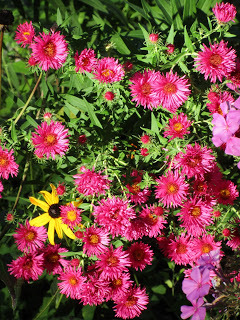 That night the temperature plunged. On the first day of October I got up and turned on the heat. On the second day I realized that I would have to remember where we put the winter clothes to find something to wear.... Oh yeah, sweaters, boots, umbrellas, the old routines come back to us.
That night the temperature plunged. On the first day of October I got up and turned on the heat. On the second day I realized that I would have to remember where we put the winter clothes to find something to wear.... Oh yeah, sweaters, boots, umbrellas, the old routines come back to us.
 And, of course I've had a lingering cold all week. Nevertheless, a fond look back at -- well, just a matter of days ago. All that watering, especially in plants condemned to grow in pots, their roots imprisoned, enabled some of the annuals to keep flowering. In the top photo posted here, we have dahlias with red and yellow blossom.
And, of course I've had a lingering cold all week. Nevertheless, a fond look back at -- well, just a matter of days ago. All that watering, especially in plants condemned to grow in pots, their roots imprisoned, enabled some of the annuals to keep flowering. In the top photo posted here, we have dahlias with red and yellow blossom.
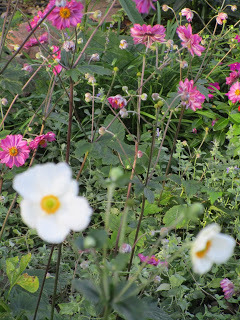 A hollyhock with a deep red blossom (second photo). A new perennial, which I picked up after seeing one at a friend's house that grew nine feet tall before the flower spike was cut in half by a gust of wind. In the foreground of the photo, some violet asters that flowered nicely in September and are now beginning to fade.
A hollyhock with a deep red blossom (second photo). A new perennial, which I picked up after seeing one at a friend's house that grew nine feet tall before the flower spike was cut in half by a gust of wind. In the foreground of the photo, some violet asters that flowered nicely in September and are now beginning to fade.
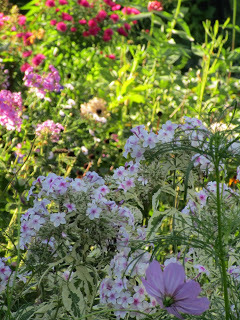 Some hardy mums planted last year against a low wall. (Fourth photo down.) A tall red aster, the most colorful of all the plants still blooming (seen in the third photo down and also at the end of the column). This one was given to us a couple years ago by neighbors. The last of the yellow Black-eyed Susans, a staple bloomer over the last three month, is seen in the top of the two red aster photos.
Some hardy mums planted last year against a low wall. (Fourth photo down.) A tall red aster, the most colorful of all the plants still blooming (seen in the third photo down and also at the end of the column). This one was given to us a couple years ago by neighbors. The last of the yellow Black-eyed Susans, a staple bloomer over the last three month, is seen in the top of the two red aster photos.
 Some white flowering anemone show with the dark pink ones behind it (fifth photo down). A photo of various flowering plants with a tall phlox that gives white blossoms and pink centers dominating in the foreground (sixth photo down).
Some white flowering anemone show with the dark pink ones behind it (fifth photo down). A photo of various flowering plants with a tall phlox that gives white blossoms and pink centers dominating in the foreground (sixth photo down).
Published on October 02, 2015 12:28



